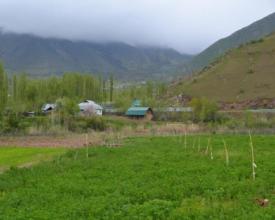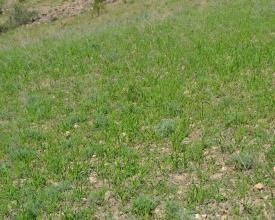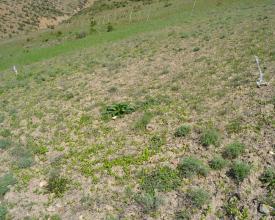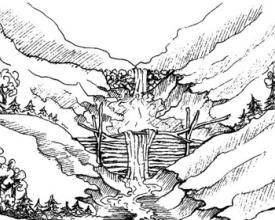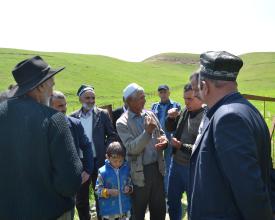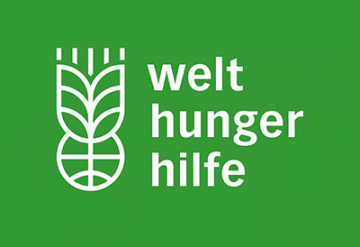
Cultures annuelles pluviales adaptées
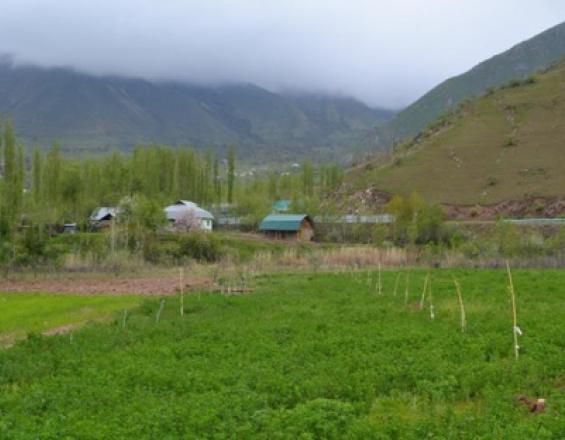
Bien qu'environ 95 % de la production de denrées de base au Tadjikistan soit cultivée dans des champs irrigués, les cultures pluviales sont particulièrement importantes pour les petits exploitants agricoles. Les cultures pluviales correspondent aux conditions climatiques des districts du projet puisqu'elles occupent des zones étendues qui ne peuvent pas être irriguées en raison de la topographie du terrain et/ou du coût de la mise en place d'une infrastructure d'irrigation.
Le choix d'un emplacement approprié est particulièrement important dans le cas des cultures annuelles pluviales. Au Tadjikistan, les mois d'été sont chauds et secs. Les dernières précipitations du printemps surviennent généralement entre la mi-mai et le début du mois de juin.
En outre, les précipitations hivernales et printanières sont très variables d'une année à l'autre, ce qui souligne l'importance de cultiver des espèces indigènes adaptées au climat.
Il est fortement recommandé de cultiver un mélange diversifié d'espèces afin de garantir la fertilité des sols sur les terres non irriguées et la conservation des sols.
Contexte
Défis à relever
La promotion des cultures annuelles pluviales dans le contexte de l'amélioration de la biodiversité et des services écosystémiques pose des défis économiques, car la préparation du sol pour les cultures annuelles pluviales nécessite beaucoup de main-d'œuvre et d'intrants. De plus, en raison des mois d'été chauds et secs, seules les cultures tolérantes à la sécheresse réduisent le risque de mauvaises récoltes.
Le risque relativement élevé d'érosion du sol constitue également un danger concret, car le sol est labouré ou n'est pas recouvert de végétation pendant la majeure partie de l'année. Cela est d'autant plus vrai que les fortes pluies du printemps sont de plus en plus fréquentes, ce qui entraîne l'érosion du sol, voire des glissements de terrain et des coulées de boue. Au Tadjikistan, il n'est pas possible de semer des cultures de couverture après la récolte de la culture principale (juillet, août), car à cette époque de l'année, il n'y a pas d'eau disponible. Il est fortement recommandé de laisser les résidus de la récolte sur les champs pour protéger le sol, comme cela se pratique dans d'autres pays, au lieu de les utiliser comme fourrage pour les animaux.
Emplacement
Traiter
Résumé du processus
- Les techniques sans labour et les mesures de conservation de l'eau visent toutes deux à accroître la disponibilité de l'eau pour les cultures annuelles pluviales.
- Le contrôle des ravines et les barrages de retenue, la technique du non-labour et les mesures de conservation de l'eau visent à réduire l'érosion du sol et donc le risque de coulées de boue et d'inondations en aval.
- La prévention de l'érosion préserve la fertilité du sol et donc la possibilité de pratiquer des cultures annuelles pluviales avec de bons résultats.
Blocs de construction
Cultures diversifiées (cultures oléagineuses particulièrement importantes pour les champs pluviaux)
La plantation de différentes cultures annuelles dans un ordre particulier pendant plusieurs années sur le même champ, également connue sous le nom de rotation des cultures, contribue à assurer la durabilité à long terme du sol, étant donné que les cultures ont des besoins différents en termes d'éléments nutritifs. Cela permet d'éviter l'accumulation et la propagation de maladies et de parasites transmis par le sol. Au Tadjikistan, de nombreux agriculteurs préfèrent cultiver les mêmes cultures commerciales, par exemple des céréales dans les zones pluviales, plutôt que d'appliquer la rotation des cultures, car à court terme, cela permet d'augmenter les revenus. Afin d'éviter les effets négatifs à long terme, les cultures oléagineuses (lin, tournesol et carthame) et les légumineuses (pois chiches, pois verts et lentilles) peuvent être utilisées pour promouvoir la rotation et la diversification des cultures. Les légumineuses fixent l'azote et améliorent ainsi la fertilité des sols. La rotation des cultures peut être combinée avec la pratique de l'absence de labour pour obtenir un effet encore meilleur.
Voici un exemple de rotation sur trois ans :
- Année 1. Culture céréalière, par exemple blé d'hiver
- Année 2. Légumineuses, par exemple lentilles, pois chiches
- Année 3. Cultures oléagineuses, par exemple le carthame
La rotation des cultures annuelles avec des plantes fourragères vivaces telles que la luzerne ou l'esparcet peut également être envisagée, car elles ont un effet très positif sur la fertilité du sol.
Facteurs favorables
- De nombreux agriculteurs ont remarqué que leur récolte diminuait et que les infestations par les parasites et les maladies augmentaient dans leurs champs pluviaux s'ils cultivaient continuellement des céréales, et ils sont donc impatients d'essayer la rotation des cultures.
- Les oléagineux et les légumineuses attirent les pollinisateurs, améliorent l'alimentation des familles et sont commercialisables.
- Certaines espèces d'oléagineux et de légumineuses, comme le carthame et les lentilles, n'ont besoin que de peu d'eau pour croître et sont résistantes aux températures élevées, ce qui leur permet de résister au changement climatique.
Leçon apprise
- Des machines spéciales doivent être disponibles pour la culture de plantes annuelles pluviales alternatives, par exemple des tracteurs à un seul essieu avec une faucille pour la récolte des cultures oléagineuses comme le carthame.
- Dans le cas des cultures oléagineuses qui doivent être transformées en carthame, il est nécessaire de produire une certaine quantité de récolte pour que le transport vers un moulin en vaille la peine.
Contrôle des ravines et barrages de retenue
Les rigoles se développent facilement sur les sites dégradés et escarpés lors de fortes pluies et finissent par s'élargir pour devenir des ravines. Souvent, la zone de plantation des cultures annuelles pluviales est traversée par des ravines. La construction de barrages de retenue est nécessaire pour contrôler l'érosion et capturer les nutriments, le limon et l'humidité. Des matériaux vivants ou morts peuvent être utilisés pour la construction de barrages de retenue. En outre, les barrages de retenue doivent être renforcés par la plantation de buissons et d'arbres le long des ravines. Comme les rigoles prennent généralement naissance au-dessus de la parcelle prévue, cette zone doit également être prise en compte. Pour les matériaux vivants, il est recommandé de planter des arbres fruitiers et des buissons. L'investissement dans le colmatage des ravines et les barrages de retenue est gratifiant car il peut générer un certain rendement et un certain revenu à l'avenir. Cependant, les matériaux vivants attirent également le bétail, d'où la nécessité de clôturer la zone.
Facteurs favorables
- Cette technique ne nécessite pas de compétences spécifiques et est peu coûteuse, à condition que les matériaux de construction soient disponibles localement et que les agriculteurs soient prêts à apporter leur force de travail.
- Des arbustes, des buissons et des arbres d'espèces locales comme le prunier, l'aubépine, l'épine-vinette, le cerisier argenté, etc. peuvent être plantés pour colmater les ravines, ce qui, outre la prévention de l'érosion, permet de produire des fruits comestibles et du bois de chauffage.
- Le colmatage des ravines et les barrages de retenue réduisent le risque de coulées de boue et d'inondations potentielles en aval.
Leçon apprise
- La mise en place et l'entretien de cette technique nécessitent une main-d'œuvre relativement importante et, bien qu'elle n'apporte pas de bénéfices immédiats, les agriculteurs doivent être convaincus des avantages qu'elle présente.
- Souvent, une famille d'agriculteurs n'est pas en mesure de colmater à elle seule une ravine, ce qui nécessite la collaboration des propriétaires des champs voisins.
Pas de labour
La technique traditionnelle de travail du sol au Tadjikistan, qui consiste à utiliser une charrue ou un disque pour briser et retourner la surface du sol, entraîne une perte de fertilité par la destruction de la matière organique, une réduction de la capacité de rétention de l'eau et l'érosion du sol, en particulier dans les zones en pente. Par conséquent, le travail du sol dans les champs de cultures annuelles pluviales devrait être limité au minimum. Afin de prévenir les effets négatifs des méthodes de culture traditionnelles, les agriculteurs sont encouragés à appliquer des techniques sans labour ou à faible labour. En appliquant la technique sans labour, le sol n'est pas perturbé car seule une petite fente est ouverte pour y placer les semences et, éventuellement, l'engrais. Dans le cas de la technique de faible labourage, le sol est cultivé superficiellement à l'aide de disques, mais il n'est pas retourné du tout comme c'est le cas lors du labourage. Les deux techniques peuvent être appliquées à l'aide de tracteurs à un seul essieu (deux roues pour les collines) qui sont promus par le projet. Le non-labour ou le labourage réduit doit être effectué le long des courbes de niveau dans les zones en pente.
Facteurs favorables
- La préparation du champ par la technique du semis direct ou du labourage réduit les coûts par rapport au labourage, car elle nécessite moins de carburant.
- La technique du non labourage augmente la teneur en matière organique du sol, et donc sa fertilité, l'infiltration de l'eau et sa capacité de rétention.
- Moins de semences sont nécessaires car elles sont placées directement sur place et non dispersées comme dans la technique traditionnelle.
- L'infestation par les maladies est réduite car les plantes sont alignées et le vent peut mieux souffler à travers le peuplement et sécher les feuilles après la pluie ou la rosée.
Leçon apprise
Néanmoins, la technique du semis direct nécessite un équipement spécialisé qui, dans de nombreux cas, n'est pas encore disponible dans le pays. Des expériences positives ont été observées dans d'autres projets utilisant des tracteurs à essieu unique équipés de matériel de semis direct. Pour un meilleur résultat et une plus grande sécurité, le tracteur à essieu unique doit être conduit par un opérateur expérimenté et le propriétaire du champ doit débarrasser le sol des pierres.
Il convient également de noter que la technique du semis direct stimule la croissance des mauvaises herbes, au moins pendant quelques années, jusqu'à ce qu'une solide couche de paillis puisse être construite pour supprimer les mauvaises herbes. L'utilisation d'herbicides doit être évitée dans la mesure du possible. La lutte contre les mauvaises herbes pendant cette période doit plutôt se faire par un désherbage manuel ou en ligne à l'aide de chevaux, d'ânes ou de tracteurs.
Mesures de conservation de l'eau (récupération de l'eau par des tranchées ou des terrasses)
Au Tadjikistan, les précipitations varient selon les saisons. Au printemps, les précipitations sont relativement importantes, tandis que les mois d'été sont chauds et secs. L'eau d'irrigation provient des eaux de fonte. Selon le type d'utilisation des terres et les conditions climatiques locales, différentes activités de collecte et de conservation de l'eau peuvent être entreprises afin de la rendre disponible pour les cultures annuelles.
L'eau provenant de la neige et de la pluie peut être récoltée en installant des tranchées le long des courbes de niveau ou des terrasses. Les tranchées doivent être discontinues et déplacées, selon le schéma d'un échiquier. Les tranchées doivent être creusées sur une largeur de 1 mètre, une longueur de 1,5 à 2 mètres et une profondeur de 0,5 mètre. Cette méthode présente plusieurs avantages importants :
- Elle permet l'infiltration de l'eau, la rendant ainsi disponible pour les cultures annuelles.
- Empêche le ruissellement de l'eau
- évite l'érosion et la dégradation du sol, le ravinement et les glissements de terrain.
Facteurs favorables
- L'augmentation de la rétention d'eau est particulièrement importante pour les cultures annuelles pluviales, car celles-ci ne peuvent pas être irriguées artificiellement et dépendent donc des réserves d'eau dans le sol.
- Le changement climatique entraîne une augmentation du stress hydrique pour les cultures annuelles pluviales et accroît donc la pression pour la mise en œuvre de mesures de collecte et de conservation de l'eau.
Leçon apprise
De nombreux agriculteurs ne possèdent pas leur propre tracteur et font appel à des propriétaires de tracteurs pour labourer leurs terres. Souvent, ces derniers ne veulent pas labourer les courbes de niveau, sous prétexte que le moteur est plus sollicité, au point que l'essieu pourrait se briser. Par conséquent, il est préférable que les propriétaires des champs acquièrent des tracteurs à essieu unique, seuls ou en groupe, pour installer des courbes de niveau ou des terrasses dans leurs champs.
Impacts
Les cultures annuelles pluviales adaptées ont un fort impact sur la fertilité des sols, améliorée par le labourage en courbes de niveau et la culture de variétés diversifiées, ainsi que par la rotation des cultures. Cela est également essentiel pour la productivité et la capacité de rétention d'eau du sol qui, à son tour, conduira à une récolte stable et à la sécurité alimentaire et nutritionnelle.
La dégradation des terres est stoppée et les variétés traditionnelles et locales de cultures annuelles sont conservées et encouragées.
La mise en culture de terres stériles a un impact économique positif en fournissant des revenus supplémentaires et des opportunités de travail.
En outre, la diversité biologique des plantes et des insectes est considérablement améliorée par l'application de mesures de lutte intégrée contre les ravageurs. Les murs en pierre naturelle et les clôtures naturelles et vivantes utilisées pour contrôler l'érosion et récolter l'eau offrent un habitat et des cachettes aux insectes et aux autres pollinisateurs.
Bénéficiaires
Les agriculteurs désireux de diversifier les cultures pluviales en cultivant des variétés locales adaptées aux conditions climatiques.
Histoire

La vallée isolée de Rasht, située à la frontière kirghize, peut s'enorgueillir d'une longue histoire de culture d'arbres fruitiers. Récemment, les agriculteurs des bassins versants de Jafr et Mazar ont redécouvert leur patrimoine de pratiques agricoles dans le cadre de notre projet sur la biodiversité et les services écosystémiques dans les paysages agraires. S'appuyant sur les connaissances et l'expérience encore existantes dans les communautés, ils font revivre non seulement les anciennes variétés locales d'espèces fruitières, mais aussi les légumes et les céréales. Le goût des légumineuses comme les lentilles, qui sont rarement cultivées de nos jours, rappelle des souvenirs oubliés depuis longtemps. Sa'dullo Hojiev a été le premier des agriculteurs du bassin hydrographique de Mazar à oser replanter une ancienne variété locale. En présentant sa parcelle, il raconte sa redécouverte des lentilles : "Nous ne les utilisions plus depuis longtemps et nous étions sur le point de les oublier, mais nous nous sommes rendu compte qu'elles étaient en fait très savoureuses ! Cette tentative lui a valu les remerciements et l'admiration bien mérités de tous les visiteurs. Tout en réintroduisant et en préservant les semences traditionnelles, les agriculteurs s'efforcent de cultiver des produits alimentaires novateurs. Très bientôt, l'odeur du pain de seigle fraîchement cuit évoquera des souvenirs du passé parmi les agriculteurs et leurs familles. En redécouvrant leur terre, ils développent non seulement des ressources précieuses qui peuvent fournir de la nourriture et des moyens de subsistance à leurs familles, mais ils maintiennent également la relation essentielle de leurs communautés avec leur paysage agricole unique.
